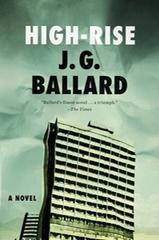 "Later, as he sat on his balcony eating the dog, Dr. Robert Laing reflected on the unusual events that had taken place within this huge apartment building during the previous three months." From that promising start, J.G. Ballard's High-Rise (1975) takes an express elevator into violent absurdity and social criticism when the residents of a luxury high-rise devolve into warring tribes. The 40-story, 1,000-unit building is its own self-contained city, one that inexplicably descends into a sort of urban Lord of the Flies as the wealthy upper floors, the vast expanse of middle-floor professionals, and the working-class lower floors battle over elevators, staircase landings and swimming pools. As the building's utilities fail and food becomes scarce, the surviving residents succumb to their deepest, darkest human desires.
"Later, as he sat on his balcony eating the dog, Dr. Robert Laing reflected on the unusual events that had taken place within this huge apartment building during the previous three months." From that promising start, J.G. Ballard's High-Rise (1975) takes an express elevator into violent absurdity and social criticism when the residents of a luxury high-rise devolve into warring tribes. The 40-story, 1,000-unit building is its own self-contained city, one that inexplicably descends into a sort of urban Lord of the Flies as the wealthy upper floors, the vast expanse of middle-floor professionals, and the working-class lower floors battle over elevators, staircase landings and swimming pools. As the building's utilities fail and food becomes scarce, the surviving residents succumb to their deepest, darkest human desires.
High-Rise's literal class war uses black humor and farcical violence to critique modern living and social stratification, among other targets. It ranks among Ballard's (1930-2009) best-known novels, which also include Crash (1973), a story about sexual attraction to car crashes; a series of post-apocalyptic sci-fi novels from the 1960s (The Drowned World, The Crystal World, The Burning World); and the semi-autobiographical Empire of the Sun (1984). A film adaptation of High-Rise, directed by Ben Wheatley, starring Tom Hiddleston, Jeremy Irons, Sienna Miller, Luke Evans and Elisabeth Moss, was released in 2015. High-Rise was last published in 2012 by Liveright ($14.95, 9780871404022). --Tobias Mutter

